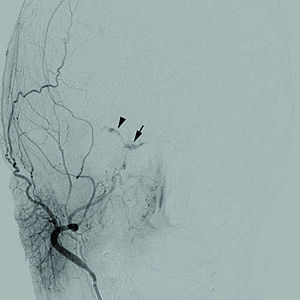Cerebrovascular disease
| Cerebrovascular disease | |
|---|---|
 |
|
| Cerebral angiogram of a carotid-cavernous fistula | |
| Classification and external resources | |
| ICD-10 | I60-I69 |
A cerebrovascular disease is a vascular disease of the cerebral circulation. Arteries supplying oxygen to the brain are affected resulting in one of a number of cerebrovascular diseases. Most commonly this is a stroke or mini-stroke and sometimes can be a hemorrhagic stroke. Any of these can result in vascular dementia.
Hypertension (high blood pressure) is the most important contributing cause because it damages the blood vessel lining exposing collagen where platelets aggregate to initiate a repair. If maintained, hypertension can change the structure of blood vessels (narrow, deformed).
Blood pressure affects blood flow in narrowed vessels causing ischemic stroke, a rise in blood pressure can cause tearing of vessels leading to intracranial hemorrhage.
A stroke usually presents with an abrupt onset of a neurologic deficit, attributable to a focal vascular lesion. The neurologic symptoms manifest within seconds because neurons lack glycogen, so energy failure is rapid.
Causes of cerebrovascular disease can be divided into: atherosclerosis, embolism, aneurysms, low flow states, and other rare causes. Major modifiable risk factors include:
Once a reduction in blood flow occurs, that lasts seconds the brain tissue suffers ischemia. If the interruption of blood flow is not restored in minutes, the tissue suffers infarction followed by tissue death. When the low cerebral blood flow persists for a longer duration, this may develop into an infarction in the border zones (areas of poor blood flow between the major cerebral artery distributions). In more severe instances, global hypoxia-ischemia causes widespread brain injury leading to a severe cognitive sequelae called hypoxic-ischemic encephalopathy.
...
Wikipedia
